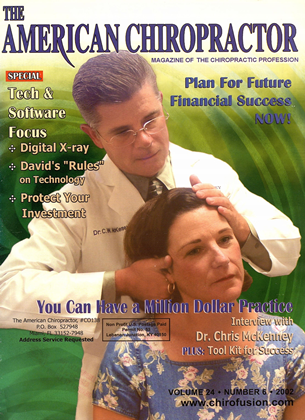Changing the Treatment of Soft Tissue Injuries A CLINICALLY RESEARCHED, INNOVATIVE treatment modality is changing the way chiropractors are treating soft tissue injuries—including the most difficult repetitive stress diagnoses. The mode of treatment, the Graston Technique, offers expanded options for treating all chronic and acute disorders. In less than a year since its introduction to the profession (November 2001), more than 300 chiropractors nationwide have been trained in the technique. National University of Health Sciences academians and clinicians have given the modality their blessing by adding the Graston Technique to the curriculum this fall. The technique has made advocates out of skeptics. "I never believed that the sensitivity of my hands could be enhanced. I do now," says renowned soft tissue expert Warren I. Hammer, MS, DC, DABCO. Hammer, author of Functional Soft Tissue Examination and Treatment by Manual Methods, finds the Graston Technique "indispensable in his approach to soft tissue problems." Internationally-known sports chiropractor Thomas E. Hyde, DC, DABSP, says the Graston Technique is "one of the most innovative soft tissue forms of treatment to come along in many years." In addition to improving patient outcomes, Hyde believes that "doctors can add longevity to their careers by using the Graston Technique." The cornerstone of the patented Technique, developed more than ten years ago, is a set of six stainless steel instruments. Use of these specially-designed instruments is a key element of the treatment protocol. Skillfully trained clinicians use the Graston Technique to help prevent acute soft tissue injuries from becoming chronic, including conditions such as low-back strain, neck, wrist and foot pain. The technique helps the clinician identify, evaluate and treat injured tissue better and more thoroughly, thus returning the patient to normal function sooner. The instruments also eliminate nearly all stress on the clinician's hands and upper extremities. It is true that necessity is the mother of invention, as the instrument development bears out. David Graston sustained a knee injury while trick skiing in 1987. Surgery left him with very limited range of motion that conventional therapies failed to resolve. Together with Andre Hall, an elite collegiate athlete, the two combined their knowledge of the musculoskeletal system with Graston's experience in the tool and die industry to create the first instruments. They, along with businessman Michael I. Arnolt, formed TherapyCare Resources, Inc., and an outpatient clinic in 1994. Arnolt is president of the company, which today focuses on teaching, training and licensing the Graston Technique. Initial research of the Graston Technique was conducted at Ball Memorial Hospital and Ball State University in Muncie, Indiana, in 1991-92. Clinical data gathered from outpatient clinics, over seven years substantiated that more than 80% of soft tissue conditions treated resulted in attaining increased function and decreased pain. Douglas G. Perry, Ph.D., at the Indiana University School of Informatics, conducted the study. "The results of the study were significant," according to M. Terry Carey, MS, PT, MTC, Assistant Clinical Professor, Indiana University School of Allied Sciences. Many of the subjects were treated with other modalities, according to Carey, "but nothing worked as well as the Graston Technique." Carey has been treating patients and training instructors in the technique for eight years. Currently, the Graston Technique is the subject of three independent randomized controlled clinical studies—including studies at Texas Back Institute and New York Chiropractic College. Results of these clinical trials should be completed within the next year. The Graston Technique is an interdisciplinary treatment that has a wide following in the outpatient market, and in industrial, academic, professional and collegiate sports arenas. Included in the network of Graston Technique-licensed organizations are Community Hospitals of Indianapolis and more than twenty professional sports teams, among them the Seattle Supersonics, Philadelphia 76ers, St. Louis Cardinals, Milwaukee Bucks, Colorado Avalanche and the Miami Heat. Nationally, many universities use the technique, including the University of Michigan, Indiana University, University of Wisconsin and the University of Illinois. Major corporations, including Subaru-Isuzu Automotive, Navistar and SupcrValu, use the Graston Technique to keep employee insurance claims and lost productivity to a minimum. | The Graston Technique website, www.erastonterhnique.rom. is an excellent resource for additional information and research on the applications and success of the technique. Information can also be obtained by calling toll-free 866-926-2S28.
 View Full Issue
View Full Issue









